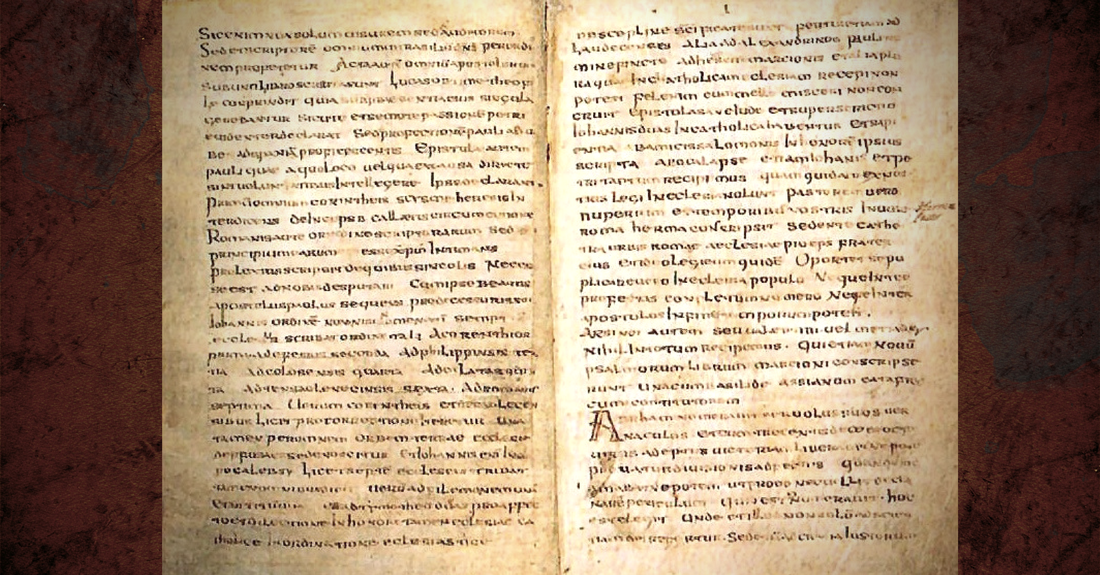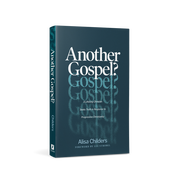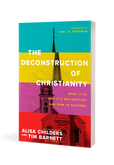|
In order to diminish the importance and relevance of the Bible, it's common for skeptics to point out that the early Christians didn't even have an official Bible. They claim that what we now call the "New Testament" wasn't compiled until hundreds of years after the life of Christ and the Apostles, when church councils convened to decide which books were "in" and which ones were "out." Famously, Dan Brown, in his best-selling book, The DaVinci Code, even alleged that the Emperor Constantine chose the books at the council of Nicaea in AD 325. (1) The Muratorian Fragment is a big deal because its very existence is evidence that these notions are not true. What is the Muratorian Fragment? Sometimes called the "Muratorian Canon," the fragment is an ancient manuscript that includes a list of New Testament books. While the fragment itself dates from the 7th or 8th century, the list of biblical books it contains dates from around AD 180. (2) Other than a highly abridged collection by the heretic Marcion, it is the oldest list of New Testament books we have, and it affirms 22 out of the 27 books. This is remarkably early to have such a comprehensive canon. When speaking of the biblical canon, some scholars insist that the word canon can only be applied to the final, closed list of books that was officially sanctioned by the church in later centuries. However, many prominent scholars disagree. Dr. Michael Kruger writes, "The term canon can be employed as soon as a book is regarded as 'Scripture' by early Christian communities." (3) The Muratorian Fragment shows us which books early Christians considered to be Scripture. What do you need to know about the Muratorian Fragment? 1. It affirms all four Gospels, the book of Acts, all 13 epistles of Paul, along with Jude, 1 John and 2 John, and Revelation. (There is also a possibility that 3rd John is included but that is disputed.) What this tells us: There was widespread agreement regarding most of the books of the New Testament by the end of the 2nd century. 2. It mentions the non-canonical Apocalypse of Peter but testifies to the fact that not everyone was in agreement about its authority. What this tells us: There definitely was some disagreement over certain books, but it highlights the fact that there was general agreement over most of them. 3. It references the Shepherd of Hermas as a book that was widely read and appreciated among early Christians but was rejected as Scripture because it was written "very recently in our times." What this tells us: Early Christians understood the concept of canon and recognized certain attributes in canonical books by rejecting anything written after the time of the Twelve Apostles (the apostolic era). This means the canon was, in principle, already closed by the beginning of the 2nd century, when the Apostles were no longer alive. (4) Why is the Muratorian Fragment a big deal? Remember the claim that Constantine chose the books of the New Testament? Other than the fact that there is no historical evidence to support this assertion, the Muratorian Fragment existed before he was even born, and the official canon wasn't finalized until about 60 years after his death. Constantine is certainly an interesting historical figure, but he did not determine the canon. The Muratorian Fragment demonstrates that as early as the late 2nd century (not even 100 years after the last of the Apostles died), there was a core canon that was affirmed by Christians and accepted as Scripture on par with the Old Testament. And that is a very big deal! Please subscribe to have my weekly blog posts delivered directly to your inbox, and join the conversation on Facebook and Twitter!
References:
(1) Dan Brown, The DaVinci Code (Anchor, 2009) p. 251-252 (2) Andreas J. Kostenberger & Michael J. Kruger, The Heresy of Orthodoxy (Crossway, 2010) p. 157 (3)Michael J. Kruger, The Question of Canon: Challenging the Status Quo in the New Testament Debate (IVP Academic, 2013) p. 35 (4) Kostenberger & Kruger, p. 170-171
12 Comments
3/14/2017 12:49:57 am
Dear Alisa,
Reply
3/14/2017 12:34:51 pm
Hi Herman,
Reply
Dalee Thomas
3/14/2017 02:12:57 pm
Im a bit confused by the article. It states the fragment is from the 7th century but that its info is from the 2nd century? If the fragment is dated the 7th century wouldnt that make the list a 7th century list? Please elaborate.
Reply
Alisa Childers
3/14/2017 06:22:02 pm
Hi Dalee. The Muratorian Fragment is a collection of theological works including treatises from early church fathers and early Christian creeds, so all of the works copied in it are from different time periods. One of the reasons scholars date the canon list to the late 2nd century is because it says that one of the books in the list, the Shepherd of Hermas, was written "very recently, in our own times, in the city of Rome, while his brother, Pius, was occupying the bishop's chair of the church of the city of Rome." So they know it was from that particular time period and could be dated no later than AD 200. A couple of scholars challenged the dating and tried to put it closer to the 4th century, but that has not been accepted by the vast majority of the scholarly community. The generally accepted date is AD 170-180.
Reply
Emily
3/19/2017 12:45:23 am
Questioning the validity of Scripture seems to be a trend not only in secular circles but also in the church. The rising argument is that we must define things by "what your heart says" because even Scripture has fallacies. In my search for the validity of Scripture, one of the harshest arguments against it was the canonical argument of the books of the New Testament. Thank you, Alisa. This has been great as usual and I will be looking into the books referenced. Stay strong in the Lord.
Reply
barry
4/24/2017 04:20:19 pm
Emily,
Reply
Alisa Childers
4/24/2017 09:51:32 pm
Hi Barry, the Muratorian Fragment is a collection of different works from different time periods. The presence of the NT list within it, and it's date is what is significant regarding canon. It lets us know what the general consensus was. Regarding the other works in the fragment, they would have to be assessed theologically on their own merits.
Brian
2/6/2021 09:18:38 am
Barry, I don't understand your challenge to the Gospel of John in this fragment. Could you explain your concern to me? I keep reading the fragment and your comments over and over again and I just don't get it.
barry
4/25/2017 06:01:53 pm
Correct...and the MF's testimony to how John's gospel contents came about, is in the same section mentioning the canonical NT books. So however early you date this list, you are dating the vision-explanation for John's gospel that early too.
Reply
Alisa Childers
4/25/2017 08:31:00 pm
I didn't make a claim regarding the testimony about John's gospel, which is a different subject. Your comment is irrelevant to this post, which is about the dating of the canonical list within the MF, not the theological content of other works it contains.
Reply
barry
4/27/2017 06:11:36 pm
I disagree that my post was irrelevant, the MF's testimony to the origin of John follows immediately after John's gospel is named as the fourth gospel. When you assign a date to the canonical list, you are assigning a date to a story about the origin of John's gospel, that most of today's conservatives, such as yourself, do not believe represents the truth.
You have said in this article that the Muratorian fragment consists of the earliest list of the new testament canon. You have said that it affirms 22 of the 27 books of the new testament. Are the 5 remaining books not in the list because they are not affirmed or is it because people at that time didn't consider it scripture/inspired? I am assuming that you mean that they did not consider it inspired/scripture. And these books being, Hebrews, James,1st Peter, 2nd Peter and possibly 3rd Jhon.
Reply
Your comment will be posted after it is approved.
Leave a Reply. |



 RSS Feed
RSS Feed


